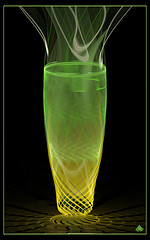Holy spritz! Water delivers flavors
 In a NYT story entitled, “To Enhance Flavor, Just Add Water,” Harold McGee explains–perhaps counterintuitively–that adding water to (alcoholic) beverages amplifies their flavors and aromas. To the tape:
In a NYT story entitled, “To Enhance Flavor, Just Add Water,” Harold McGee explains–perhaps counterintuitively–that adding water to (alcoholic) beverages amplifies their flavors and aromas. To the tape:
How can water reduce one sensation and amplify another? Both alcohol and aroma molecules are volatile, meaning they evaporate from foods and drinks and are carried by the air to the odor receptors high up in the nasal cavity.
Aroma molecules are also more chemically similar to alcohol molecules than they are to water, so they tend to cling to alcohol, and are quicker to evaporate out of a drink when there’s less alcohol to cling to.
This means that the more alcoholic a drink is, the more it cloisters its aroma molecules, and the less aroma it releases into the air. Add water and there’s less alcohol to irritate and burn, and more aroma release.
Given that there’s a notion that “alcohol delivers flavors” in wine, this is a useful contribution to the discussion.
Of course, it takes a lot of water to make wine. Sometimes that water has been added in the late innings of winemaking, a process called “watering back,” with the volume measured in “Jesus units,†an oblique reference to the Marriage of Cana.
In his column, McGee adds water to a glass of 15% zinfandel, bringing it down to 12%. He describes the difference: “A glass of the full-strength wine tasted hot, dense, jammy and a little sulfurous, while the diluted version was lighter all around but still full of flavor, tarter, more fruity than jammy, and less sulfurous…the watered-down wine was surprisingly pleasant, and maybe more suited to summer evenings than the intense original.”
Consumers adding water to their own wine in the glass is rarely discussed in wine geek circles. But in the broader wine-drinking world, it does happen, most often in the spritzer, where sparkling water is added to (white) wine. Perhaps that carbonation further amplifies the aromas? More trials may be necessary here. But one thing’s for sure: spritzers can still make you tipsy. This was immortalized in the episode of The Simpsons Viva Ned Flanders. In it, Homer takes his God-fearing neighbor to Vegas where Flanders breaks down and orders a white wine spritzer. The next morning, the two wake up married to waitresses.




On July 29th, 2010 at 11:15 am ,Damien wrote:
This should be contrasted with Clark Smith’s adamant insistence of not rinsing wine glasses with water, but leaving a trace of wine so as to not throw the wine to be tasted out of balance. In practice, and especially for tasting pours, I always prefer to avoid pouring into a glass rinsed with water, but then we don’t pour that many 15% wines. This is fertile ground for experiments if someone has the time.
On July 29th, 2010 at 12:30 pm ,Gerry Dawes wrote:
Now, I know what I should be doing with the 14.5% to 16% samples I have been tasting, water them down. I know a couple of winemakers in Spain that I am going to try this on the next time I taste wines with them. Of course, they may croak from apoplexy when they see me watering down their 50-100 Euro a bottle wines.
On July 29th, 2010 at 1:15 pm ,Robbie C. wrote:
I read once that Napoleon’s favorite wine was Clos de Beze (with water in it). Wasn’t it the fashion to water down wine ages ago?
I definitely add water to wine occasionally. I have found that with wines such at Pinot noir it brings out more of a floral character in the wine..In Cabs and Zins it definitely brings out the fruit (for example, I might taste cherry flavors I didn’t notice before adding water.)
The only problem, for me, is that it totally changes the weight of the wine. After adding water I no longer really consider it wine. It becomes more for drinking (glug, glug) than for tasting/sipping.
On July 29th, 2010 at 6:58 pm ,Daniel wrote:
And it was considered unacceptable to not water your wine down in ancient Greece and Rome, only drunkards consumed wine without water.
Granted, the water back then may not have been that safe to drink without wine to make it somewhat safer.
Now the big question will be, what kind of water? Distillled, fancy bottled water, or straight from the tap. Probably not the last one unless filtered a few times, unless if you live somewhere like up here in the Pacific NW where the water is fantastic. I can’t even brush my teeth with the water down in So. Cal, much less drink it.
On July 30th, 2010 at 11:48 am ,Dan wrote:
While it does seem, on the face of it, counterintuitive, if you stop and think about things like a Scotch and Soda, or Bourbon and water, it’s not done to extend the drink, but to bring out the aromas. Not surprising that it works well with wine too, though it’s always good to have the authority of McGee behind you when you tell people these things.
On August 1st, 2010 at 6:49 pm ,Dave Erickson wrote:
Just to expand a bit on Dan’s comment: A single-malt Scotch aficionado will nose and taste a glass of whisky straight, then add a bit of water to release more aromas.